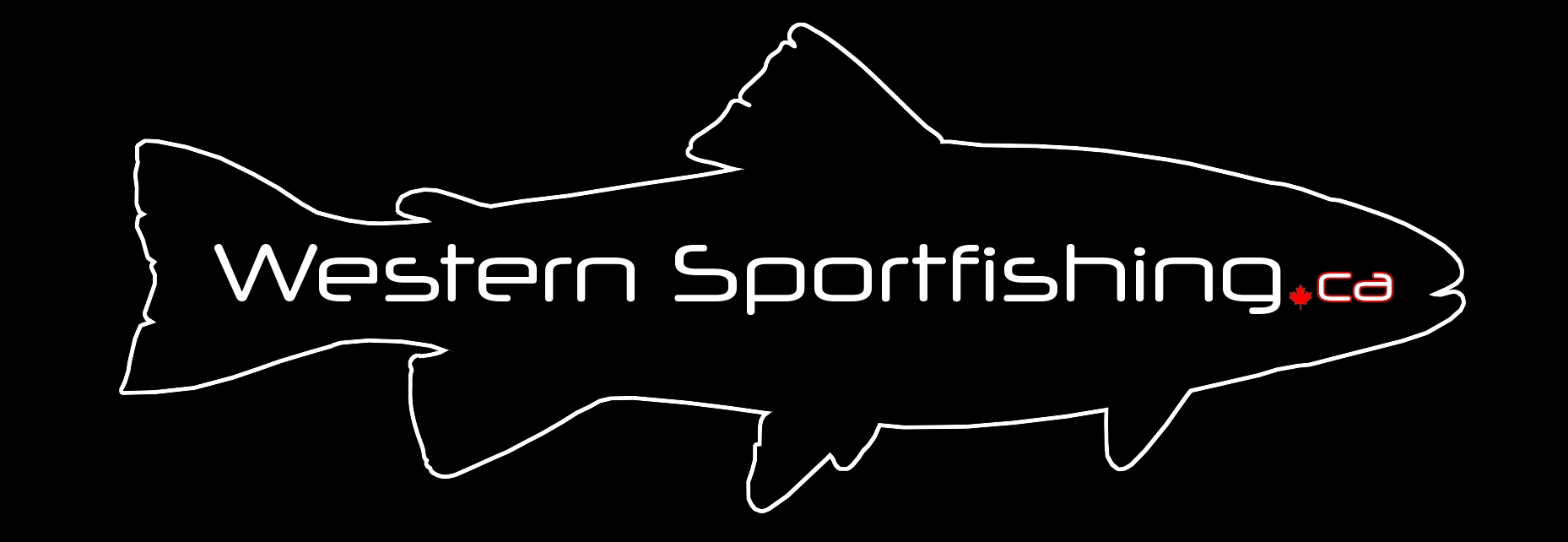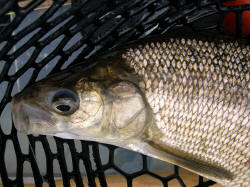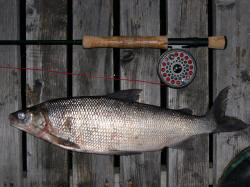
Open Water Lake Whitefish
When we think of lake whitefish, most of us envision
sitting in an ice shack, peering down a hole in the ice, and
anticipating the bite. What a lot of people don't realize is
that these gems can be caught fairly consistently throughout the
open water season as well. Between pike, walleye, lake trout,
and even perch; lake whitefish seem to be the bottom of the order
when it comes to the open water season.
I have to admit, I love the rush that spring pike and
walleye bring on the fly, but the day I decided to go for lake
whitefish on the fly, changed my perspective completely. Not
only do these fish love to take a fly, but they fight like a train
flying off the tracks.
It was early spring, and I was out with Andy and
Steven. We had the boat anchored in our favorite spring
location: six feet of water, surrounded by weed bed edges rich in
forage for any species in the lake. It was calm, and warm, and
the pike and walleye were heavy on the feed. All of a sudden,
we noticed the lake whitefish begin to feed near the surface.
"This is my shot," I said to myself.

I quickly rigged up a fly rod with a candy cane
chironomid, and an olive chironie as a dropper, about 16" below.
I set the indicator for a depth of about four feet, as we were in
shallow water to begin with. I cast the rig out there, and
began a slow retrieve.
It didn't take long, and I had a lake white of about
20" inhale the offering. After a short battle won by the fish,
I quickly got my flies out there again, although I had my doubts.
I mean, what are my chances
of hooking another one?
Two minutes went by, and the indicator slowly
twitched, and pulled below the surface. I pulled up, set the
hook, and the battle was on. Hard runs of peeling line, and
nasty head shakes ensued. The whitefish tore around, and under
the boat, coming close to wrapping my line in the back anchor rope.
It was like battling a mix of smallmouth bass and rainbow trout.
Five minutes in, and the fish began to tire. Andy got the net
ready, and netted a fantastic fish.
It was a 21" lake whitefish with a girth reflecting
the amount it had been feeding. Amazing!
After witnessing the exciting battle, Andy and Steven
wanted a shot at these fat fish. The rest of the trip went
great, with many more whites being hooked.
That day out got us to target these fish more often,
and we began to catch on to their locations, and what fly patterns
to use. It also became apparent how picky these fish can be at
times.
When choosing a location for lake whitefish, it can
be very easy at times, though other times it is a guessing game.
The first, and easiest way, is to look for whitefish surfacing in an
area. If there are consistent rise forms, then that would be a
great place to begin (though most times it is not that easy).
Mostly, you have to be on the look-out for reed lines, with
extending sand flats, and slight drop-offs. The insides of
points usually produce well. And, if you own a fish finder, it
can be useful for finding under water weed beds, which are where
much food such as scuds, chironomids, shiners, perch minnows, and
more, are available to the whitefish to gorge on.

The most consistent seasons for lake whitefish are
spring and fall, although summer can sometimes offer surprise dry
fly action if you are lucky. These fish can be fussy at times,
and sometimes you either can't catch them, or you can't find them.
It is all part of the lake whitefish challenge.
If you fish at a body of water with lake whitefish in
it, break away from your pike and walleye for a little while and try
these fish. Once you hook one, I am sure you will be targeting
them more often. Who knows, maybe more often than pike and
walleye...
Recommendations:
Rod: 5-8 wt (depending on size of lake whitefish)
Line: WF Floating
Leaders/tippet: 4-8 lb
Flies:
Streamers- #8-12 white wooly
bugger, perch imitations, BH Mohair leech
Nymphs- #10-16 chironomid patterns, bead head nymphs
Dry Flies- chironomid emerger, Dave's Hopper, Elk
Hair Caddis
